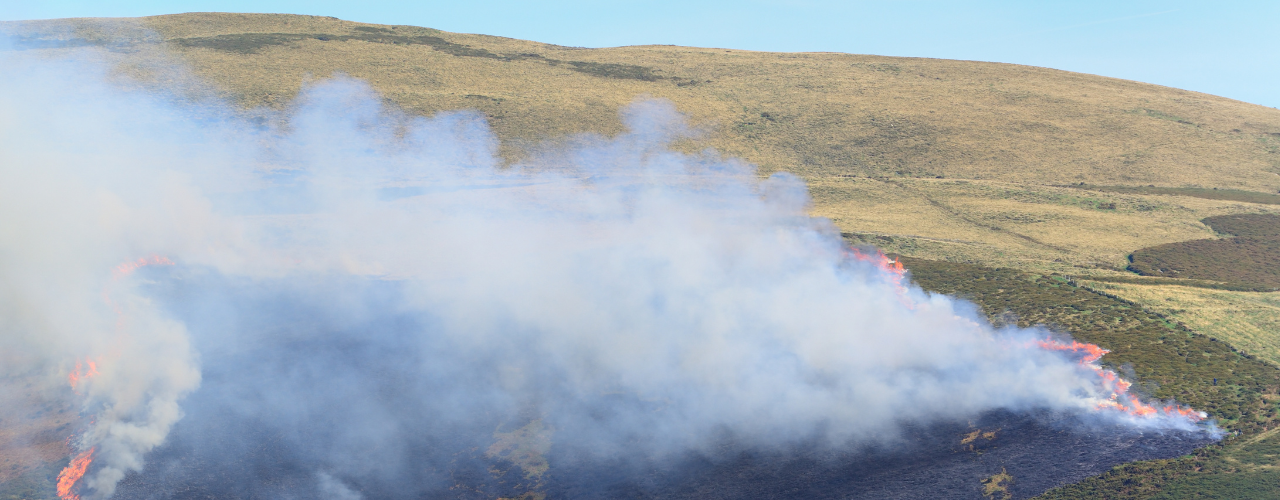
The hills are alive… with the sound of fire engines.
Less than three weeks into the nesting season, which is legally closed for gorse clearing, Ireland has already experienced several serious incidences of wildfires in hills around the country. While the smoke may have cleared from the wildfires which ravaged the hills around Kerry, Laois and Wicklow the ecological devastation will remain for years.
Fire – an appropriate management tool?
Wildfires in Ireland are a particularly thorny issue. Fire is not a natural part of Ireland’s ecosystem functioning so our native flora and fauna are not adapted to this particular type of disturbance. While our wet green environment may not naturally lend itself to spontaneous combustion it has none the less been used for years as a land management practice for gorse, heather and other shrubby plants creating and maintaining a specific type of habitat which has become so normalised that it is difficult to imagine what the alternatives are. On the other hand, burning as a management tool can result in widespread destruction of above ground vegetation, damage to the soil structure and biodiversity and exposing the soil to erosion, air pollution, carbon dioxide emissions, water pollution and displacement and destruction of birds and other animals. Herein lies the issue. The perception of what constitutes good land management practices and good ecological practices can fundamentally misalign depending on what the desirable outcomes are deemed to be – grazable land eligible for subsidies or intact ecosystems managed for biodiversity.
Fire – beyond management to destruction
What we are now seeing now however goes beyond a discussion about what the appropriate land management should be. Uncontrolled burning on Irelands hills has been a problem for decades putting both people and planet at risk. This is an argument that has played out every spring with relatively little done to improve the situation to this point. The hills still burn to the point where, year upon year, the fire service are call out to protect lives and livelihoods from this uncontrolled burning. In 2019 the fire service was called out to 2291 fires located in bogs, gorse and grasslands, with counties having as much as 26% (Wicklow) and 46% (Kerry) of fire call-outs being in these locations. These extremely high numbers highlight the strain these types of fires put the fire service under. With many of these fires set deliberately these actions are not merely accidents but criminal.
The specific mix of poorly designed agricultural policies which penalise landowners for land that is not grazable, lack of enforcement and accountability of law breaking and an ambivalence by some farmers and farming associations to the huge environmental cost of this damaging practice has resulted in the particular bind that we are in. The consequences of this destruction is also wide ranging including implications for public health due to air pollution, contributing to the climate and biodiversity crisis as well as impacting the potential of these areas to contribute to the local economy in terms of tourism.
Need for a new normal – An Ecological Conversion
The solution to this problem will not lie with more legislation, the ones that are already there are ineffective. It will also not be fully realised by simply penalizing those who set the fires, by then the damage is already done and it only takes one person to break the law to destroy entire hillsides. What will be required is a plan for managing our hills that not only protects the intrinsic value of our countryside but also ensures that the farmers and land managers who previously benefitted financially from clearing the shrubs are not left out in the cold. Designing agricultural policies and schemes will be vital, this must include paying farmers for the ecological benefits their works incurs. An integral ecology approach that is flexible but with a clear and unambiguous vision of what success looks like will be needed to bring all of these threads together. Considering the considerable gap that currently exists in our perception of the natural environment of our uplands this will be difficult but there is already much work being done to try and bridge this gap.
Changing hearts and minds to stop the occurrences of wild fire is one part of the puzzle, we also need to reckon with the extensive ecological damage that has already been inflicted as well as reduce the susceptibility to wildfire. The possibilities for restoration and sensitive management are countless. Restoring blanket bogs across the country, by blocking drains and raising water tables, would not only reduce the risk of fires but also act as a carbon store, a biodiversity haven and mitigate the risk of flooding and drought by sorting water and releasing it slowly. High nature value farming as well as natural regeneration of native forests have the potential to breathe life back into our lifeless hills creating a mosaic of different habitats where extensive agriculture and biodiversity can flourish.
The scars of past fires, over grazing and drainage mingle together to form a denuded landscape, but one that still contains the potential to again be alive with the sounds of nature.

